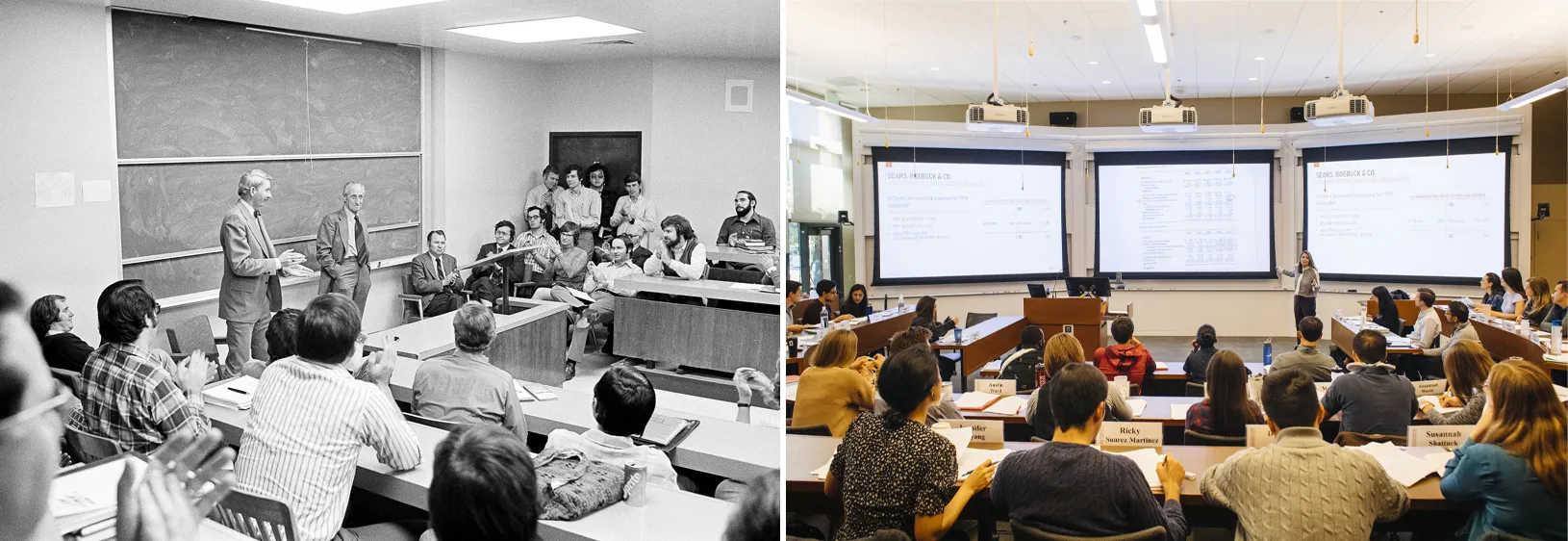Knight Management Center Marks 10-Year Anniversary
The state-of-the-art complex, designed for “structured serendipity,” prepares to open — again.
May 27, 2021

The Knight Management Center was designed to maximize outdoor interactions, because, as one professor puts it, “classrooms can be confining.” | Elena Zhukova
Spring quarter 2021 at Stanford Graduate School of Business is still a mix of remote and hybrid classes, but as the school marks the tenth anniversary of the construction of the Knight Management Center, the unique complex has never been more appreciated, and a full-time return to its campus can’t come soon enough.
“The campus is starting to come to life; there’s a lot of energy and vibrancy here for the first time in a year, which is great,” says Stanford GSB Dean Jonathan Levin. “This last year has been a revelation in terms of how much you can do in a virtual environment, but it’s also been a reminder of what really matters here, which are the human connections people form and how important it is to be able to bump into and talk to people — the sort of structured serendipity this physical campus provides.”
Space to Create and Collaborate
Opened in April 2011, the new center relocated Stanford GSB from an aging three-building complex to an eight-building campus set on 12.5 acres. Funding for the $345 million facility was led by Nike founder Philip H. Knight, MBA ’62, who in 2006 contributed the $105 million down payment for the project, the largest gift ever to a business school at that time. Construction coincided with a revamped and more personalized Stanford GSB curriculum that required more — and more varied — classroom space for hands-on instruction, small-group leadership labs, and team-based learning.
On the old campus, “we didn’t have seminar rooms, we didn’t have breakout rooms, and we didn’t have places for collaboration and interaction,” says Robert Joss, the Philip H. Knight Professor and dean, emeritus, who oversaw Stanford GSB from 1999 to 2009. Joss secured approvals and funding for the new management center and directed its design planning and early construction. “We wanted to be open to the university, and our old space wasn’t inviting. There were so many things that just didn’t align with the culture we hoped to create.”

Classrooms and other spaces in the original campus (left) failed to align with the kind educational culture that Stanford GSB administrators hoped to create. | Left: Jose Mercado / Stanford News Service; Right: Elena Zhukova
Today, the Knight Management Center features more than 100 flexible classrooms, breakout rooms, and study rooms, along with innumerable tucked-away informal spaces for spur-of-the-moment conversation. Other heavily used collaboration sites include the Anne T. and Robert M. Bass Center’s library and meeting spaces, and the NGP CoLab, a hub where interdisciplinary teams of students from across Stanford University meet to develop new business ideas, and where students huddle together to design and test new business concepts.
That was where Miri Buckland and Ellie Buckingham, both MBA ’19, developed the concept for their social design platform The Landing. “The vast majority of the moments that added up to us starting our company happened there, where we spent a lot of time whiteboarding to get our ideas out,” Buckland recalls. “We’d have Post-it notes covering the boards, and there would often be faculty or lecturers or other people coming and going, and we’d have a lot of passing conversations with them that would end up being really helpful. Those were conversations we wouldn’t have had otherwise, and they were really important to our process.”
A Campus Crossroads
The school’s collaborative design continues outdoors. Scattered within and around Town Square, King Community Court, and the McCoy Family Courtyard are 30 lounges and terraces strategically placed for discussion.
“I don’t know if it’s the energy of the people here, the happenstance interactions, or just the way the seating is set up, but the heart of campus is between Arbuckle Dining Pavilion and Town Square,” says Bernadette deRafael, director of facilities, hospitality, and emerging projects for Stanford GSB. “As soon as you come out of your classes or the Bass Center, you come into Town Square, where you can grab some coffee or food. It’s a beautiful indoor-outdoor space where you’re always running into people.”
Buckland agrees: Those spaces hold special memories for her and her cofounder. “Ellie and I would be outside as much as we possibly could, running around from TA Associates Café to the library, finding any little bench where we could sit down and take a call,” she says. “We actually incorporated our company from a table in Town Square.”
While other business schools such as Harvard are set apart from their universities, the Knight Management Center sits across the street from student residences, and was deliberately located on the Stanford campus to make its common areas enticing to all, says Hayagreeva “Huggy” Rao, the Atholl McBean Professor of Organizational Behavior and Human Resources at Stanford GSB.
“I often see colleagues from political science or sociology coming here to eat; this is where we have the crossroads, not just of the GSB, but I’d argue of other parts of the university as well,” Rao says. “This is the commons of the GSB, and a commons is where you encounter diversity of thought, ideas, and practice. To me, that’s the essence of the Knight Center.”

Fostering collaboration was a defining principle when reimagining the school’s physical design. | Elena Zhukova
Those spaces have also become classrooms, he says.
“We teach differently now,” says Rao. “Particularly in our executive programs, we use a lot of the outdoor spaces for people to do exercises in negotiations or collaboration or case discussions. Classrooms can be confining, and it’s where people perform. When we ask them to take a walk outdoors, it’s real. It loosens them and creates some informality and results in a very different kind of conversation that hopefully opens the imagination.”
Art That Inspires
The school’s grounds include a collection of public art, including five pieces by California artist Peter Wegner commissioned specifically for the Knight Management Center. Each focuses on the idea of transformation, including “Monument to Change as It Changes,” a huge panel outside Zambrano Hall made up of thousands of sets of colored flaps programmed to display ever-changing patterns.
“Public art installations are incredibly important, and these pieces, especially ‘Monument to Change as It Changes’ have become iconic to Stanford,” says Tricia Seibold, creative director for Stanford GSB. “But they aren’t just here to be pretty backdrops for photos. They create conversation areas for students and faculty and staff to gather. I hope when students see these works, they’re reminded of change and possibility. The art reflects the intent of the campus, and it was all designed with these collaborations in mind.”
Sustainability to Create Good Stewards
The campus — 50% of which is open space — was also designed to support Stanford GSB’s commitment to environmental leadership, and it received a LEED Platinum rating for environmental sustainability from the U.S. Green Building Council. Classroom buildings are relatively narrow, with floor-to-ceiling windows that maximize natural light and significantly reduce the need for electric lighting. Photovoltaic roof panels provide 12.5% of the complex’s energy demands, and an automated window system used in the summer flushes warm air from the buildings and draws in cool nighttime air. A catchment system under the walkways captures runoff from rain and irrigation systems. When possible, greywater and rainwater is used for flushing toilets, reducing the amount of potable water that enters the sewer system up to 80%.
“We want our students to be mindful of the enormous challenges the planet faces and leave the business school as good stewards of the environment and conscious of their responsibility in that regard,” says Garth Saloner, the Botha-Chan Professor of Economics at Stanford GSB, who served as dean from 2009 to 2016 and oversaw the completion and opening of the Knight Management Center. “That’s hard to instill if your classes are taking place in a facility that itself is environmentally irresponsible.”
A decade after its construction, the Knight Management Center continues to do the job it was designed to do, Saloner says.
“This campus has been hugely successful at promoting collaboration and community; it pervades the learning experience here, and it’s been hard to be deprived of this facility for 15 months,” he says. “Coming back means not only being back with each other, but being back with each other in this incredible space.”
For media inquiries, visit the Newsroom.
Explore More
Stanford GSB Professor Neil Malhotra Named Carnegie Fellow

Stanford GSB Researchers Discuss the Ideas They’re Most Excited About

Room to Grow: The Cannabis Industry Can’t Wait to Go Mainstream
